- Home
- About
- Map
- Trips
- Bringing Boat West
- Migration West
- Solo Motorcycle Ride
- Final Family XC Trip
- Colorado Rockies
- Graduates' XC Trip
- Yosemite & Nevada
- Colorado & Utah
- Best of Utah
- Southern Loop
- Pacific Northwest
- Northern Loop
- Los Angeles to NYC
- East Coast Trips
- 1 Week in Quebec
- Southeast Coast
- NH Backpacking
- Martha's Vineyard
- Canadian Maritimes
- Ocracoke Island
- Edisto Island
- First Landing '02
- Hunting Island '02
- Stowe in Winter
- Hunting Island '01
- Lake Placid
- Chesapeake
- Provincetown
- Hunting Island '00
- Acadia in Winter
- Boston Suburbs
- Niagara Falls
- First Landing '99
- Cape Hatteras
- West Coast Trips
- Maui
- Mojave 4WD Course
- Colorado River Rafting
- Bishop & Death Valley
- Kauai
- Yosemite Fall
- Utah Off-Road
- Lost Coast
- Yosemite Valley
- Arizona and New Mexico
- Pescadero & Capitola
- Bishop & Death Valley
- San Diego, Anza Borrego, Joshua Tree
- Carmel
- Death Valley in Fall
- Yosemite in the Fall
- Pacific Northwest
- Utah Off-Roading
- Southern CA Deserts
- Yosemite & Covid
- Lake Powell Covid
- Eastern Sierra & Covid
- Bishop & Death Valley
- Central & SE Oregon
- Mojave Road
- Eastern Sierra
- Trinity Alps
- Tuolumne Meadows
- Lake Powell Boating
- Eastern Sierra
- Yosemite Winter
- Hawaii
- 4WD Eastern Sierra
- 4WD Death Valley +
- Southern CA Deserts
- Christmas in Tahoe
- Yosemite & Pinnacles
- Totality
- Yosemite & Sierra
- Yosemite Christmas
- Yosemite, San Diego
- Yosemite & North CA
- Seattle to Sierra
- Southwest Deserts
- Yosemite & Sierra
- Pacific Northwest
- Yosemite & South CA
- Pacific Northwest
- Northern California
- Southern Alaska
- Vancouver Island
- International Trips
- Index
- Tips
- Books
- Photos/Videos
- Search
- Contact
San Francisco, CA
Monday, May 11, 2015 - 1:15pm by Lolo
0 miles and 0 hours from our last stop - 3 night stay
Travelogue
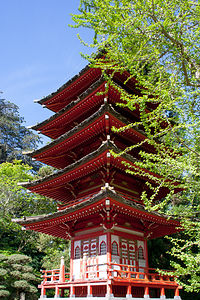 Japanese Tea GardenMy flight from Seattle went smoothly and before I knew it, I was being swept away by another Uber car. This time I used a feature called UberPool, which is only available in a few cities, San Francisco being one of them. The way it works is, when you request an Uber car, they pair you up with another rider requesting a similar route. As long as you are willing to share your ride with someone else, you can get from the airport to anywhere in San Francisco for $15. There was no way this could be profitable for Uber, and I am sure this is just a temporary ploy to drive competitors out of business, but in the meantime, it sure made getting from the airport convenient and inexpensive.
Japanese Tea GardenMy flight from Seattle went smoothly and before I knew it, I was being swept away by another Uber car. This time I used a feature called UberPool, which is only available in a few cities, San Francisco being one of them. The way it works is, when you request an Uber car, they pair you up with another rider requesting a similar route. As long as you are willing to share your ride with someone else, you can get from the airport to anywhere in San Francisco for $15. There was no way this could be profitable for Uber, and I am sure this is just a temporary ploy to drive competitors out of business, but in the meantime, it sure made getting from the airport convenient and inexpensive.
The timing was perfect. My Uber dropped me off at Andrew and Celeste’s apartment, just as Andrew was getting home from work. It was so, so good to see him after such a long lapse of time.
Since they both had worked all day, I offered to take them out to dinner, but they insisted on making dinner for me instead, so we could just relax. Those two really have their act together. Between work and an extremely active social/workout schedule, they still manage to keep their apartment immaculate, eat extremely healthy and delicious meals, stay in incredible shape, entertain friends, and most importantly smile through the whole hectic process.
They felt badly that they had to work during my stay, but I told them no worries, as I would be very happy entertaining myself during the day, and spending time with them in the evenings. All I needed was a city map, a good pair of walking shoes, and my kindle -- oh yes, and a good itinerary, which Andrew, wonderful son that he is, had diligently prepared for me. He had mapped out an extremely detailed walking tour, including interesting sights, places to eat, places to just sit and read, etc. It looked perfect. If there is such a thing as a “planning” gene, Andrew certainly has mine. Herb, however, would probably more accurately call it a Type A personality gene. Whatever you want to call it, it looked like I had a great day ahead of me.
I should have more children, so that I could have more great cities to visit. I will have to talk to Herb about that when we reunite.
Day 1 – Golden Gate Park, Corona Heights, Buena Vista Park, and Planet Granite
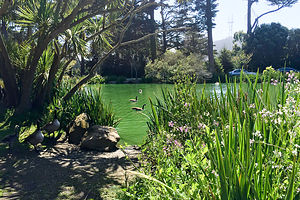 Stow LakeAs per Andrew’s plan, I left his apartment bright and early and headed south towards Golden Gate Park, stopping first at the Cinderella Bakery for a spinach croissant and a cup of coffee. I sat contentedly at an outside table, just watching the cars and people go by. Having lived in suburbia my entire life, it is a both novelty and a treat to be able to get around on foot, with so many exciting things going on all around you.
Stow LakeAs per Andrew’s plan, I left his apartment bright and early and headed south towards Golden Gate Park, stopping first at the Cinderella Bakery for a spinach croissant and a cup of coffee. I sat contentedly at an outside table, just watching the cars and people go by. Having lived in suburbia my entire life, it is a both novelty and a treat to be able to get around on foot, with so many exciting things going on all around you.
I took a picture of my croissant and texted it to Andrew to show him that I was up and out and starting to implement his plan before heading on to Golden Gate Park.
Golden Gate Park is to San Franciscans what Central Park is to New Yorkers, only, believe it or not, it is actually 20% larger. It’s a half mile wide, and stretches for three miles from the east to the Pacific Ocean. Unlike Central Park, however, it is not surrounded by tall buildings, so it has a much less urban feel to it. How nice for Andrew and Celeste to live so close to this beautiful park.
I entered the park from 6th Avenue and soon found myself in a lovely courtyard between the de Young Museum and the California Academy of Sciences, where I became mesmerized by a group of elderly Chinese people doing Tai Chi. Their graceful, slow, but focused movements were extremely calming. I found my own stress levels going down just watching them.
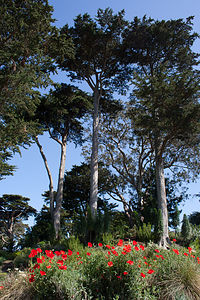 San Francisco Botanical GardensI continued on and entered the gates to the Japanese Tea Garden. After paying my $8 admission, I wandered the lovely paths of the garden, past a beautiful red pagoda, an authentic teahouse, and a zen garden. I was the first visitor there, so I had the garden entirely to myself. It was so serene and peaceful.
San Francisco Botanical GardensI continued on and entered the gates to the Japanese Tea Garden. After paying my $8 admission, I wandered the lovely paths of the garden, past a beautiful red pagoda, an authentic teahouse, and a zen garden. I was the first visitor there, so I had the garden entirely to myself. It was so serene and peaceful.
Then my cell phone rang and broke my reverie. It was Herb, who said he was only a day or two away from San Francisco on his long motorcycle journey. He started discussing the logistics of storing the motorcycle, getting the motorhome out of storage, picking me up, etc., which really was not conducive to the mindset I was in right now. I don’t think he appreciated it when I told him he was ruining my “zen moment.”
In attempt to regain my serenity, I continued meandering along the stone paths, stopping at the pond to stare at the colorful koi for a while. Soon there were about a dozen of them at my feet staring up at me open mouthed. Either they liked me a lot or they were used to getting a handout. I have a feeling it was the latter.
Next, I came to an arched drum bridge, so steep that I wasn’t even sure if it was meant to walk across. When I got closer, I saw that there were horizontal rungs built into the walkway over the bridge that you could use sort of like the rungs of a ladder. As with a ladder, you had to descend backwards so that you had something to hold onto. Since my sprained ankle was still a bit tender, I decided to not risk calamity and just photograph the bridge instead.
Although drum bridges were originally designed with such high arches to allow barges to fit underneath, their purpose in formal gardens is purely aesthetic. In a garden, the arch is always situated in such a way that the bridge and its reflection in the pond combine to form a full circle. That is why they are also called Moon Bridges
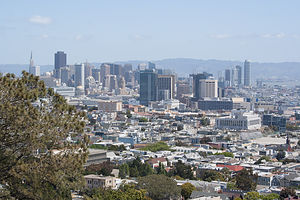 View from Corona HeightsAcross from the Japanese Tea Garden is another one of the park’s gems -- the San Francisco Botanical Gardens, which I happily learned was free on the second Tuesday of every month. I took my brochure of the gardens and tried to follow the map systematically through each of its gardens of the world – California Native Garden, Redwood Grove, Andean Cloud Forest, Chilean garden, Mesoamerica, etc., etc., but its lovely winding paths, which branched off from other lovely winding paths, definitely made navigating challenging for someone as spatially impaired as myself. I kept finding myself back in Mesoamerica. Eventually, I was able to make my way through most of the garden’s 55 acres and enjoy many beautiful and interesting plants from around the world.
View from Corona HeightsAcross from the Japanese Tea Garden is another one of the park’s gems -- the San Francisco Botanical Gardens, which I happily learned was free on the second Tuesday of every month. I took my brochure of the gardens and tried to follow the map systematically through each of its gardens of the world – California Native Garden, Redwood Grove, Andean Cloud Forest, Chilean garden, Mesoamerica, etc., etc., but its lovely winding paths, which branched off from other lovely winding paths, definitely made navigating challenging for someone as spatially impaired as myself. I kept finding myself back in Mesoamerica. Eventually, I was able to make my way through most of the garden’s 55 acres and enjoy many beautiful and interesting plants from around the world.
It was pretty amazing that so many plants from so many diverse places could thrive here, but that’s San Francisco weather for you. The Bay Area's mild temperatures, wet winters and dry summers, coupled with that famous coastal fog, provide a range of climatic conditions that exist in few other botanical gardens in the world. It’s probably the same reason so many different varieties of grapes are grown in Sonoma and Napa. I did notice that despite the drought, there was much watering going on throughout the garden. In fact, I got spritzed several times by some pretty aggressive sprinklers.
Continuing on my journey through the park, I headed over to Stow Lake to climb Strawberry Hill, the first of three hills that Andrew had assigned me – each of which would provide me with a different perspective of San Francisco.
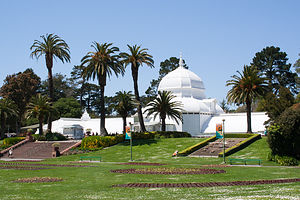 Conservatory of FlowersStow Lake is the largest of the Golden Gate Park’s man-made lakes, and on a nice day it is bustling with people recreating – joggers, walkers, paddle boaters, more people doing Tai Chi, etc. It was very pretty, and I was very much enjoying my stroll along the path that encircled it.
Conservatory of FlowersStow Lake is the largest of the Golden Gate Park’s man-made lakes, and on a nice day it is bustling with people recreating – joggers, walkers, paddle boaters, more people doing Tai Chi, etc. It was very pretty, and I was very much enjoying my stroll along the path that encircled it.
My goal, however, was to climb Strawberry Hill, located on an island in the center of the lake. I soon came to one of the two bridges that cross over to the island and followed a path to its summit. At 430 feet, it is the highest point in the park, and from the top I could see the Golden Gate Bridge, Mt. Tamalpais, as well as much of the park. I took a picture and texted it to Andrew to let him know how I was progressing on his tour.
The next task on my quest was another one of San Francisco’s many hills – Corona Heights, about a 2.6-mile walk from Stow Lake. I walked the rest of the way around the perimeter of the lake, past the boathouse and the Chinese Pagoda, and then continued east through the park, passing through the quiet and contemplative National Aids Memorial Grove.
Andrew had instructed me to walk along the Panhandle, a narrow ¾-mile long extension of the park’s eastern end, but Google Maps kept steering me towards a more direct route to Corona Heights. Who was I to argue with Google, so I just followed its directions for now with the intention of finding the Panhandle on my way back.
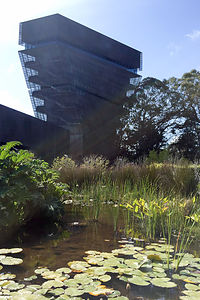 de Young MuseumWhere Andrew lives in the Inner Richmond section of San Francisco, it is quite flat, but as I made my way through the Castro and up Masonic Avenue towards Corona Heights, I was reminded of why San Francisco is famous for its hills. Andrew didn’t tell me that I would have to climb a steep hill just to get to another steep hill. I am officially counting this as a fourth hill.
de Young MuseumWhere Andrew lives in the Inner Richmond section of San Francisco, it is quite flat, but as I made my way through the Castro and up Masonic Avenue towards Corona Heights, I was reminded of why San Francisco is famous for its hills. Andrew didn’t tell me that I would have to climb a steep hill just to get to another steep hill. I am officially counting this as a fourth hill.
Before long, I saw a brown hill with a prominent red outcrop on top. I had arrived at Corona Heights. I followed one of its paths to the 520-foot summit where several people were clambering around on the rock formations at the top. The view was pretty awesome. The whole city lay before me with the Bay and Mount Tamalpais in the distance. It was extremely windy so I didn’t stay long, but I did manage to first text Andrew a picture to mark my progress.
On my way to Corona Heights, I had actually passed Buena Vista Park, the third (or fourth if you count Masonic Avenue) of the hills I was to climb. Unlike the barren and exposed Corona Heights, Buena Vista contains one of the city’s largest remaining coast live oak groves, so its summit was a lot less obvious. There are many entrances to this park, but I approached it from Buena Vista Avenue West, where I climbed about a hundred stairs and then followed a thickly wooded path to what I think was the summit – an open grassy area with a single park bench. Because of all the trees, it was hard to get an unobstructed view of the city below.
Not wanting to get lost, I walked back down the same trail that I had come up and headed north back towards the Panhandle. I was now officially in the Haight, which is what San Franciscans call the Haight-Ashbury neighborhood. Its distinction of being the locale for the 1967 “Summer of Love” is still very much a part of its culture, attested to by the numerous peace signs and tie-dye and smoke shops.
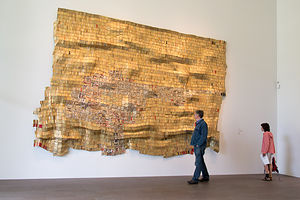 Lolo with de Young Museum ArtI stopped for lunch at the Panini Café on Haight Street and texted a picture of my sandwich to Andrew. I had the rest of the afternoon to kill, so I was in no particular hurry. Plus I was tired from walking up all those hills. I lingered over a cup of coffee watching the activity on the street and recharging my phone, which had practically gone dead due to all my navigating and texting.
Lolo with de Young Museum ArtI stopped for lunch at the Panini Café on Haight Street and texted a picture of my sandwich to Andrew. I had the rest of the afternoon to kill, so I was in no particular hurry. Plus I was tired from walking up all those hills. I lingered over a cup of coffee watching the activity on the street and recharging my phone, which had practically gone dead due to all my navigating and texting.
When my phone, and me, were recharged, I continued on, stopping first to take the obligatory picture of the Haight-Ashbury street sign, thereby forfeiting any pretense that I was a San Franciscan and not a tourist.
This time I did manage to find the Panhandle, which was much nicer to walk through than along a city street.
When I got back to Golden Gate Park proper, I stopped to rest on a bench by the Conservatory of Flowers, a beautiful, sparkling white, Victorian domed building that houses a collection of over 2,000 rare and exotic plants. I chose not to go in today – I would save that for a later visit – but spent a very nice hour, alternating between reading my Kindle and watching all the people.
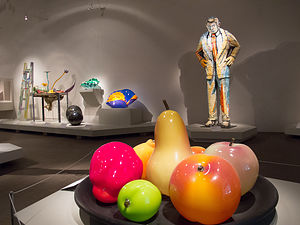 de Young Museum ChihulyOnce back at Andrew’s apartment, I texted him a picture to show him that I had successfully completed my quest, and then crashed on the couch for a well-deserved power nap. I had walked over 10 miles and climbed three hills on my injured ankle, and the day wasn’t over yet. There was still an evening of rock climbing at Planet Granite ahead of me.
de Young Museum ChihulyOnce back at Andrew’s apartment, I texted him a picture to show him that I had successfully completed my quest, and then crashed on the couch for a well-deserved power nap. I had walked over 10 miles and climbed three hills on my injured ankle, and the day wasn’t over yet. There was still an evening of rock climbing at Planet Granite ahead of me.
Andrew and Celeste usually climb at this gym three times a week. On days they do, they take their bikes to work so that they can go directly to the gym afterwards. Then, after a few hours of climbing, they ride the steep hills of the Presidio three miles back to their apartment where they make dinner around 9:30. I definitely admire their enthusiasm and energy.
So, around 6:00, I drove Andrew’s car to the gym to meet up with them. I absolutely love this gym. Even if I wasn’t climbing, I would love it for its views alone. Floor to ceiling windows look out onto the Golden Gate Bridge, Alcatraz, and the Mark di Suvero sculptures in Crissy Fields. It’s hard to keep your eyes on the climbing wall.
After climbing, we loaded their bikes on Andrew’s car – saving them that steep uphill ride home – and got a bite to eat at King of Thai Noodles, one of their favorite post-climbing restaurants.
Needless to say, I slept very well that night.
Day 2 – Smog check, Lands End, and Golden Gate Park
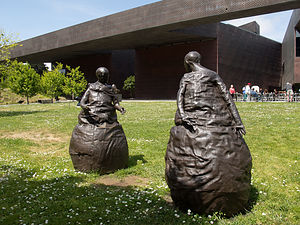 de Young Museum Outdoor SculpturesAndrew’s suggestions for how I might spend today were a little less impressive than his efforts the day before. “How about taking my car for a smog check?” Not exactly what I had in mind, but their schedules are so busy and I had the day to kill, so I said, why not – However, not before first making him feel a bit inferior to his brother in the entertaining Mommy department. “Gee, Tommy took me to the Space Needle for lunch. Sure, I’ll take your car for a smog check.”
de Young Museum Outdoor SculpturesAndrew’s suggestions for how I might spend today were a little less impressive than his efforts the day before. “How about taking my car for a smog check?” Not exactly what I had in mind, but their schedules are so busy and I had the day to kill, so I said, why not – However, not before first making him feel a bit inferior to his brother in the entertaining Mommy department. “Gee, Tommy took me to the Space Needle for lunch. Sure, I’ll take your car for a smog check.”
I googled Smog Checking stations and made an appointment at one in the Castro district, near to where I had walked the day before. Getting there required me to drive down the steepest hill I have ever driven on. It was really scary.
The car passed with flying colors, and I headed back to Andrew’s apartment to park his car so that I could walk back into Golden Gate Park to spend the day. I had enjoyed exploring the park so much yesterday that I wanted to go back and see more of it. I circled and circled Andrew’s block, but couldn’t find street parking anywhere. As I went around the block for the third time, I was getting more and more stressed and feeling more and unkind thoughts towards my son.
Finally, I gave up and decided to go somewhere where I knew I could find parking – the Visitor Center at the Lands End Lookout. Visitor Centers always have parking, and having been here last year, I knew this was a very pretty place to spend an hour or so.
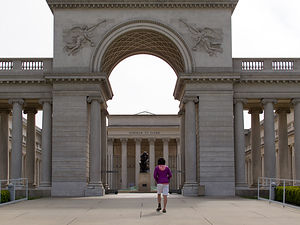 Entrance to Legion of Honor MuseumLands End is just what its name suggests, the end where the land meets the sea. It is San Francisco’s westernmost point and lies at the southern mouth of the Golden Gate, the strait that connects San Francisco Bay to the Pacific Ocean, and the source of the name for the famous bridge that spans it.
Entrance to Legion of Honor MuseumLands End is just what its name suggests, the end where the land meets the sea. It is San Francisco’s westernmost point and lies at the southern mouth of the Golden Gate, the strait that connects San Francisco Bay to the Pacific Ocean, and the source of the name for the famous bridge that spans it.
Its gorgeous rocky shoreline, cypress-covered hillside, and the ruins of the old Sutro Baths below give a sense of wildness and isolation, not something you often come across in a city of this size. However, after my explorations of yesterday, I was finding that San Francisco has many of these pockets of pristineness and natural beauty.
From the Visitor Center parking lot, I took the steep trail down to the ruins. It is hard to believe that in the 19th century this was a lavish swimming resort, with six saltwater swimming tanks (flushed daily by the tides), 517 private dressing rooms, restaurants, and 1,700 seat amphitheater, all enclosed by 100,000 feet of glass. I wandered around a bit on the grid of concrete walls, which is all that is left of its foundation.
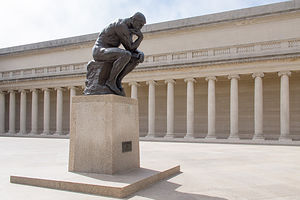 Rodin’s Thinker at Legion of Honor MuseumThere was a very cool tunnel off to the right that had openings through which I could watch the waves lapping up against its walls. It was actually kind of spooky. I wasn’t sure if this was built at the time of the baths, or later as part of the coastal trail.
Rodin’s Thinker at Legion of Honor MuseumThere was a very cool tunnel off to the right that had openings through which I could watch the waves lapping up against its walls. It was actually kind of spooky. I wasn’t sure if this was built at the time of the baths, or later as part of the coastal trail.
I hiked back up the trail to the car and called Andrew to see what I should do about parking his car. He told me that his landlord was always out this time of day, so I should just pull it into the garage, leaving enough space behind it for his landlord to fit his car later. Well, that was easy.
Once the car was safely tucked away, I set out once more on foot – the means of transportation I am most comfortable with in a city. It was already after 1:30 and I was getting pretty hungry. I yelped nearby places to eat, and up came Velo Rouge Café, a place that we had stopped to have a beer at last year when Andrew and Celeste took us on a bike tour of the city. I can still remember how refreshing that beer tasted after riding 25 miles up and down the hills of San Francisco. Hopefully, their food was just as good.
I was feeling pretty comfortable finding my way around now and tried not to rely on Google Maps. Whenever I do, I get to where I want to go, but have absolutely no idea how. Trying to do it the old fashioned way would be a good exercise in improving my somewhat limited spatial skills. So, I looked at a map and counted 2 blocks south, then 5 blocks east.
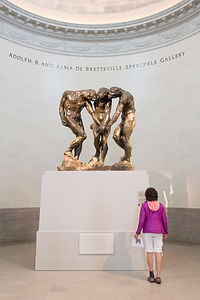 Lolo with Rodin's The Three ShadesDespite it already being close to 2:00, the café was bustling and all the outdoor tables were taken. I grabbed the last indoor table and ordered a Coppi – turkey, spinach, and Jack with a cranberry jam spread on toast. It was delicious.
Lolo with Rodin's The Three ShadesDespite it already being close to 2:00, the café was bustling and all the outdoor tables were taken. I grabbed the last indoor table and ordered a Coppi – turkey, spinach, and Jack with a cranberry jam spread on toast. It was delicious.
Then I entered Golden Gate Park, which was only one more block south, and spent a delightful hour reading my kindle on my favorite bench by the Conservatory of Flowers. I could really get used to living here.
I continued my stroll through the park and once again found myself in the courtyard by the de Young Museum. I very much wanted to visit this museum, but thought it would be a lot more fun with Herb, rather than doing it alone.
He had called me that morning to tell me that he would be arriving later that day at the Petaluma KOA where are motorhome is stored, after 19 days and 4,000 miles of driving his motorcycle from New Jersey, down the Blue Ridge Parkway, and across to the West Coast. Besides acclimating to a more stationary lifestyle, there was much work for him to do on the motorhome when he got there. He wasn’t sure how long that would take him, nor what day he would come to pick me up. I decided anyway to wait until he did to visit the museum.
However, I knew from a previous visit here that going to the top of the Hamon Observation Tower in the de Young Museum was free, so I took the elevator up and was treated to a panoramic view of San Francisco that I didn’t require me climbing a hill. Through its floor to ceiling windows, I gazed out at the Golden Gate Bridge, the Marin Headlands, the city, and all the tiny people recreating in the park.
Another great day in the Park! I happily wandered back to Andrew’s apartment – without using Google Maps – read my book in a comfy chair by their bay window and waited for them to come home from work.
That evening Celeste, Andrew, and I dined at one of their new favorites – Ragazza, on Divisadero Street, just southeast of the Panhandle. Andrew had described it as a pizza place, but it was so much more. Their thin-crust pizza and salads were phenomenal.
Day 3 – Golden Gate Park, Legion of Honor, Lands End, and Planet Granite
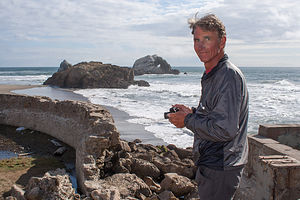 Herb at Lands EndAs I mentioned, Herb had completed his crossing of the country via motorcycle and was currently in the Petaluma KOA trying to get our motorhome ready for another family vacation. When he called, I tried to convince him to hold off on the maintenance and prep and come spend the day with me in San Francisco. We could go to museums, climb with the kids that night, and then he could take me back to Petaluma where I could help him get things ready.
Herb at Lands EndAs I mentioned, Herb had completed his crossing of the country via motorcycle and was currently in the Petaluma KOA trying to get our motorhome ready for another family vacation. When he called, I tried to convince him to hold off on the maintenance and prep and come spend the day with me in San Francisco. We could go to museums, climb with the kids that night, and then he could take me back to Petaluma where I could help him get things ready.
He must have missed me, because although he still had much work to do, he hopped in the Subaru and drove down to the city to meet me. Despite having been married for close to 30 years, our near 3-week separation made me feel as excited as if we were going on a first date. Maybe this doing things separately and then reuniting was a good thing.
Wanting to show off my new-found knowledge of the city, I took him on a tour which included several things that I had already done, but that was okay – it was fun seeing them again through someone else’s eyes.
With the intention of going to the de Young Museum, we drove into Golden Gate Park and parked along John F. Kennedy Drive. Before going to the museum, we walked around Stow Lake, past the boathouse and the Chinese pagoda, then across the bridge and up to the top of Strawberry Hill to enjoy the views of the city and the Golden Gate Bridge and Marin Headlands in the distance.
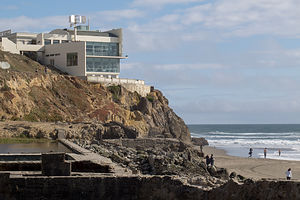 The Cliff House at Lands EndI had passed the de Young museum so many times already during my strolls through the park that it was good to finally be visiting it, although the building is beautiful and interesting enough on its own to make a visit to it worthwhile without ever stepping through its doors.
The Cliff House at Lands EndI had passed the de Young museum so many times already during my strolls through the park that it was good to finally be visiting it, although the building is beautiful and interesting enough on its own to make a visit to it worthwhile without ever stepping through its doors.
Redesigned in 2005 to help withstand future earthquakes, the museum both blends with and complements its park-like setting -- and that blending into its surroundings will become even more pronounced as the copper panels covering its façade oxidize and take on a more greenish tint. Also, if you look closely, you see that the copper panels have been perforated and textured to imitate light filtering through a tree canopy.
However, today we would enjoy the contents of this beautiful museum, which houses an impressive collection of American art from the 17th through 20th centuries, textiles and costumes, and art of Africa, Oceania, and the Americas. There was much to see, but if I were to pick out my highlights I would include the adorable wood-carved statues from Africa, the glasswork by Chihuly, and the wonderful outdoor sculpture garden, which contained many playful and thought-provoking works.
Our $10 admission included same-day entry to its sister Legion of Honor Museum, an incredible neo-classical, palace-like building that we had on a previous visit admired from the outside, but very much wanted to enter.
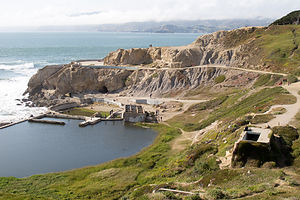 Sutro Bath RuinsGetting to the Legion of Honor required driving to Lincoln Park, a beautiful park that sits atop a hill in the northwestern corner of San Francisco overlooking the Pacific Ocean, the Golden Gate Bridge, and much of San Francisco. The museum’s spectacular setting is made even more dramatic by the imposing French neoclassical Beaux-arts Palace that was built to commemorate the Californian soldiers who died in World War, but now houses its impressive collection of Ancient and European decorative arts, sculpture, and painting.
Sutro Bath RuinsGetting to the Legion of Honor required driving to Lincoln Park, a beautiful park that sits atop a hill in the northwestern corner of San Francisco overlooking the Pacific Ocean, the Golden Gate Bridge, and much of San Francisco. The museum’s spectacular setting is made even more dramatic by the imposing French neoclassical Beaux-arts Palace that was built to commemorate the Californian soldiers who died in World War, but now houses its impressive collection of Ancient and European decorative arts, sculpture, and painting.
Hitchcock fans will recognize this as the museum where in the film Vertigo the obsessed Kim Novak goes each day to gaze at the “Portrait of Carlotta,” her dead great-great-great grandmother, who seems to possess her soul. You won’t find the portrait here though, as it was only a prop created by the studio.
The first thing we encountered when we entered its impressive courtyard was Rodin’s Thinker, whose own quite thoughtfulness seemed to suggest that we do the same.
Immediately behind the Thinker is a glass pyramid, which sits atop and provides a skylight for the special exhibition galleries below. The lightness and transparency of the glass made for an interesting contrast with the heaviness and solidity of the rest of the architecture.
Even more than the de Young, this museum’s collection included more of the art that I was personally interested in. I diligently referenced the museum layout to ensure that I didn’t miss any of the 19 galleries on its main floor, which contained the following.
- Ancient Egyptian, Greek, and Roman Art
- Medieval Art
- French and Italian Baroque and Rococo
- British Art
- 17th and 18th Century Flemish and Dutch and Flemish Paintings
- 18th to 20th Century Neoclassicism through Post-Impressionism
- Sculptures of Rodin
We were especially interested in many of the Rodin works as we had just recently visited the Rodin Museum in Philadelphia, where we had seen many of these same works – the advantage of creating in a medium that can be easily copied.
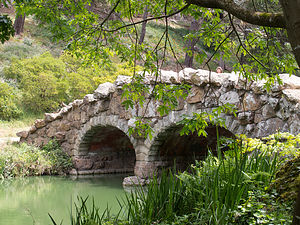 Tiny Lolo on Golden Gate Park BridgeI’d be hard pressed to pick a favorite between the de Young Museum and the Legion of Honor, but fortunately I don’t have to. They are very different both in their architecture and their collections, as was the Getty Museum and Getty Villa in L.A. How wonderful to have such a choice in such close proximity.
Tiny Lolo on Golden Gate Park BridgeI’d be hard pressed to pick a favorite between the de Young Museum and the Legion of Honor, but fortunately I don’t have to. They are very different both in their architecture and their collections, as was the Getty Museum and Getty Villa in L.A. How wonderful to have such a choice in such close proximity.
Herb and I still had about an hour to kill before meeting Andrew and Celeste at the climbing gym, so we drove the short distance to Lands End to enjoy the stunning views. Even though I had been there just the day before, Herb had never been down to the old Sutro Bath Ruins, so I enjoyed playing tour guide and showing him what I had discovered – like the spooky tunnel off to the right of the ruins.
It was approaching 6:00, so we drove over to Planet Granite to meet Andrew and Celeste for a night of indoor rock climbing. As, I have said time and time again, I absolutely love this climbing gym and can’t wait until I move out here so that I can come to it regularly.
After climbing, we went to dinner at Mandalay Burmese Cuisine, my first Burmese restaurant. Seeing our dazed expressions when reading the menu, Andrew and Celeste took over and ordered for all of us. Everything was delicious. I was expanding my palate this trip with so many wonderful dining experiences in both Seattle and San Francisco.
Rather than stay in San Francisco that night, Herb and I drove back to Petaluma to sleep in the motorhome. Herb warned me that things were a bit disorganized because I had rushed him to come down to the city to pick me up, so I was careful to not comment on the disorderly state it was in. It definitely needed a woman’s touch, further confirmed by the fact that there were only 6 items in the refrigerator, and each of them was a beer.
We both had our work cut out for us tomorrow before Andrew and Celeste arrived to spend the weekend with us.
Description
The following is in no way meant to be a comprehensive guide to San Francisco, as there are entire guide books devoted to just that. However, the following is a brief description of some of the sights in and nearby the city that I enjoyed during my stay.
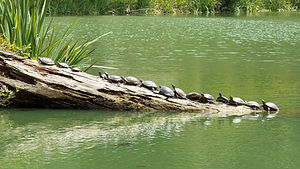 Turtle Jam in the ParkGolden Gate Park is to San Franciscans what Central Park is to New Yorkers. Its 1,017 acres make it 20% larger than Central Park. It is over three miles long (from east to west) and half a mile wide (north to south). The park design was the result of an 1870 competition, won by 24-year-old William Hammond Hall. Park highlights that I visited include:
Turtle Jam in the ParkGolden Gate Park is to San Franciscans what Central Park is to New Yorkers. Its 1,017 acres make it 20% larger than Central Park. It is over three miles long (from east to west) and half a mile wide (north to south). The park design was the result of an 1870 competition, won by 24-year-old William Hammond Hall. Park highlights that I visited include:
- The Japanese Tea Garden in Golden Gate Park is the oldest public Japanese garden in the United States. Originally created as a one-acre Japanese Village for the 1894 California Midwinter International Exposition, the property was eventually left to the care of Makoto Hagiwara, a renowned Japanese landscape architect, who expanded the garden to its current size of 5 acres. For decades, Mr. Hagiwara poured his wealth, passion, and creative talents into creating the garden until he and his family, along with approximately 120,000 other Japanese Americans were placed in internment camps. He was never allowed to return. Today, the garden is one of San Francisco’s most popular attractions, featuring pagodas, an authentic teahouse, an arched drum bridge, stepping stone paths, plants from China and Japan, and a serene koi pond and zen garden. Admission is $8 for non-residents and $6 for residents. On Monday, Wednesday, and Fridays it if free if entered by 10:00 am.
- The San Francisco Botanical Gardens has 55 acres of both landscaped gardens and open spaces, showcasing over 8,000 different kinds of plants from around the world. The Bay Area's mild temperatures, wet winters and dry summers, coupled with that famous coastal fog, provide a range of climatic conditions that exist in few other botanical gardens in the world. As a result, the Botanical Gardens are able to recreate climatic conditions from round the world, such as those found in an Andean Cloud Forest, a Chilean Garden, Mesoamerica, Southeast Asia, etc.
- Stow Lake is the largest of Golden Gate Park’s man-made lakes and a very popular spot for relaxing and recreating. There is a boathouse where one can rent a rowboat or a paddle boat or just get a bite to eat at its lake-side café, a beautiful red Chinese pagoda, and a 1-mile paved path that traces the lake’s perimeter. At the center of this doughnut-shaped lake is Strawberry Hill, an island reached by two bridges on either side of the lake. Several paths lead up to its 430-foot summit, the highest point in the park, where there are wonderful views of the Golden Gate Bridge and Mount Tamalpais.
- The National AIDS Memorial Grove, located in the eastern end of Park, is a 10-acre living memorial honoring all who have confronted this tragic pandemic can gather to heal, hope, and remember.
- The de Young is a fine arts museum located in Golden Gate Park. Founded in 1895, as an outgrowth of the 1894 California Midwinter International Exposition, it has grown to become an integral part of the cultural fabric of the city and a destination for millions of residents and visitors from around the world. In 2005, the museum was reopened in a state-of-the-art new facility that integrates art, architecture, and the natural landscape and houses the museum’s priceless collections of American art from the 17th through 20th centuries, textiles, and art of Africa, Oceania, and the Americas. There is also an outdoor sculpture garden. Admission is $10 for an adult, but also allows same day admission to the Legion of Honor.
The Legion of Honor is a fine arts museum located in Lincoln Park, in a spectacular setting overlooking the Pacific Ocean, the Golden Gate Bridge, and much of San Francisco. The museum’s spectacular setting is made even more dramatic by the imposing French neoclassical Beaux-arts building that was built to commemorate the Californian soldiers who died in World War I. Today it houses an impressive collection of Ancient art from throughout the Mediterranean and the Near East; European decorative arts, sculpture, and painting; and the largest collection of works on paper in the country. Its collection includes Rodin’s Thinker, who thoughtfully greets visitors as they enter the museum’s Court of Honor.
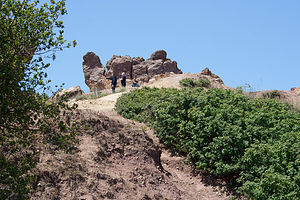 Corona HeightsCorona Heights is a hill in the Castro neighborhood of San Francisco with one of the best views of San Francisco. Its prominent red outcrop is visible from many parts of the city. In the late 1800s, Corona Heights was quarried for brickmaking materials by the infamous Gray brothers who had a brick kiln on States Street. The steep, exposed rock faces and the “crown” we see today at Corona Heights are the result of this quarrying.
Corona HeightsCorona Heights is a hill in the Castro neighborhood of San Francisco with one of the best views of San Francisco. Its prominent red outcrop is visible from many parts of the city. In the late 1800s, Corona Heights was quarried for brickmaking materials by the infamous Gray brothers who had a brick kiln on States Street. The steep, exposed rock faces and the “crown” we see today at Corona Heights are the result of this quarrying.
Buena Vista Park, in the Haight-Ashbury neighborhood of San Francisco, is the oldest park in the city, established in 1867 as Hill Park. Its name was later changed to reflect the spectacular views from its 575-foot summit. The park features secluded winding trails and one of the city’s few remaining coast live oak groves.
Lands End is a park in the northwestern corner of San Francisco located at the mouth of the Golden Gate, the strait that connects San Francisco Bay to the Pacific Ocean. A trail leads down from the Visitor Center parking lot, past a lovely hillside of cypress and wildflowers, to the ruins of the old Sutro Baths, once a lavish swimming resort in the 19th century. During its heyday, there were six saltwater swimming tanks (flushed daily by the tides), 517 private dressing rooms, restaurants, and 1,700 seat amphitheater, all enclosed by 100,000 feet of glass. The resort was destroyed by fire in 1966, but the foundations are still visible on the rocks. Nearby is an interesting cave tunnel through the hillside, with views of underwater channels.
- ‹ previous
- 2 of 9
- next ›
San Francisco location map in "high definition"
Javascript is required to view this map.
